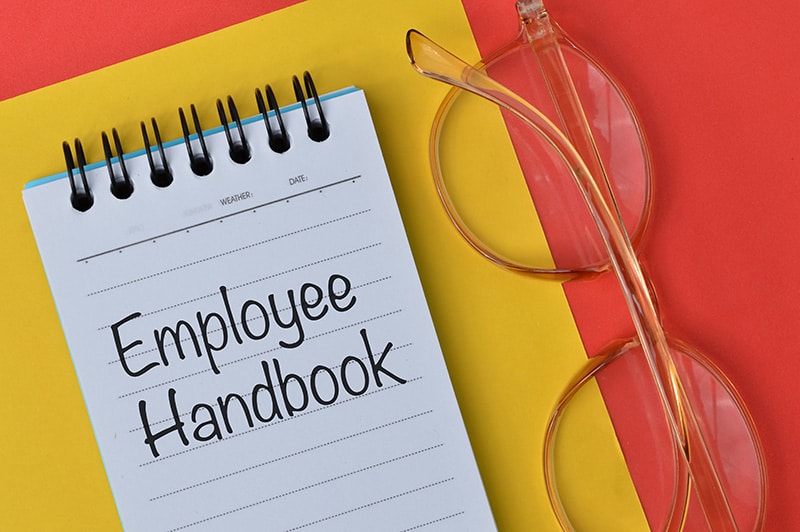Regardless of the size of your company or your industry, an employee handbook is an invaluable resource.
There is no legal requirement that businesses have an employee handbook but it’s a good idea, especially in light of the rapidly-changing work environments that have been borne out of the pandemic.
In this article, we will examine the purpose of this important workplace communication tool and share five reasons why having an updated, accurate employee handbook is so crucial in today’s evolving business landscape.
What’s the purpose of an employee handbook?
Most people think of the employee handbook as a tool to provide details about company-specific procedures and guidelines. However, it can also be used to curate and share the organization’s values, history, and mission, making it an indispensable part of the onboarding process. It often includes HR forms, policies, details about company programs, and procedures to be followed in specific situations, such as sick leave and travel reimbursement. The handbook should be written in a digestible, easy-to-understand manner that includes a description of each policy, program, or procedure. Avoid legal jargon and confusing terminology. Keep in mind that it is not intended to be a rigid, enduring resource. Rather, an employee handbook is meant to be an evergreen document that is frequently reviewed and updated as necessary to reflect changing laws and business needs.
What should be included?
Every employee handbook should clearly identify the procedures necessary for an efficient work environment. There are likely to be variations depending on the company size and industry, but standard topics include:
- Company Mission, Vision, and Values
- Anti-Harassment and Non-Discrimination Policies
- Code of Conduct
- Dress Code
- Communications Policy
- Compensation and Benefits Information
- Reviews, Promotions, and Raises
- New Hire and Separation Procedures
As the pandemic has proven, changes can happen in an instant and create mind-boggling changes in the way businesses operate. Take time to review your existing handbook and apply updates like the ones below, if necessary:
- Remote and Hybrid Work Policies
- Parental Leave and Accommodations
- Health and Wellness Benefits
Why should companies take the time to create or update their employee handbook?
Here are five key benefits you stand to gain:
- Establishes clear expectations.
An employee handbook designates explicit guidelines for conduct and performance. When difficult questions arise about policies and procedures, management can refer to the employee handbook for clarity. Additionally, employees will know what is expected of them, reducing the risk of confusion or disciplinary actions. - Ensures compliance with federal and state laws.
No matter what state you do business in or how many employees you have, your organization is subject to state and federal employment laws. Your handbook not only communicates these various entitlements and obligations to employees, but it demonstrates that your firm strives to be compliant with these regulations. - Removes ambiguity.
When an employee handbook establishes well-defined standards and procedures for a wide range of scenarios, it minimizes the guesswork involved. - Minimizes risks.
Clearly defining workplace policies and procedures can be the first step in defending a business from an array of legal issues. The best way to minimize risks is to have a practical handbook that your managers and employees can easily follow. What often happens is that companies create and distribute handbooks with the policies they think they need, but they are not adhered to. - Welcomes new employees and introduces company values.
The employee handbook offers an excellent opportunity to provide new employees with a warm welcome, giving them helpful information about policies and affirming company values. In addition to the policies and procedures that impact the workplace on a regular basis, the employee handbook can reinforce your corporate mission, culture, and vision.
A well-drafted employee handbook should be professional and informative. Be sure to have your attorney review the updated handbook for conflicting or confusing language and legal issues. Once approved, share it with all employees, be prepared to answer any questions they may have, and retain acknowledgements of receipt in their personnel files. Keep in mind that employee handbook templates can be helpful for starting points but they are rarely useful without significant adjustments. Every company is unique so don’t adopt something just because it’s in a template. You don’t know where those templates came from. Are they legal? Are they practical? Do they fit your organization? Templates are everywhere and easy to come by. Advice on what you need, and why, is where the professionals come in.
The seasoned professionals at The HR Team can review your existing handbook, guide you in drafting one for your company, or simply answer any questions you may have about particular policies. For more information, please contact us.
About The HR Team: Founded in 1996, The HR Team is a Maryland-based human resources outsourcing firm committed to developing strategic, customized solutions that respond to the unique needs and cultures of organizations of all types and sizes. Available as a one-source alternative to an in-house HR department or on an à la carte project basis, the company’s flexible service models address the full spectrum of HR needs that many organizations struggle to address. The HR Team helps clients achieve their highest level of success by providing value-driven human resources services that leave them time to focus on what they do best: directing business growth and profitability. Headquartered in Columbia, Maryland, the firm serves all of Maryland, Washington, DC, and Virginia. To learn more about The HR Team, call 410.381.9700 or visit https://www.thehrteam.com/.







